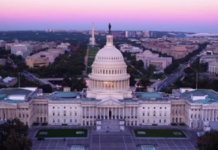
Vice President JD Vance always has his facts straight. Especially when dealing with the mainstream media.
Because JD Vance just shut down and shut up an NBC reporter with a no-nonsense answer.
Vice President J.D. Vance delivered a sharp rebuke to NBC’s “Meet the Press” host Kristen Welker during a Sunday interview, challenging her on why Republicans shouldn’t pursue more balanced congressional maps given the widespread popularity of President Donald Trump’s policies.
Vance highlighted the Texas state Senate’s recent approval of new congressional districts, which came after Texas House Democrats abandoned their quorum-breaking protest on August 18. He pointed out that many of the states those Democrats sought refuge in have long histories of maps skewed heavily in favor of liberal interests.
“First of all, Kristen, you have to ask yourself why have Democrats gerrymandered their states aggressively in the past 10 to 20 years,” Vance stated, noting the need for Republicans to counter longstanding Democratic tactics that have distorted representation nationwide.
In Massachusetts, for instance, Republicans captured 32% of the vote in recent elections, yet the state sends zero GOP members to Congress, a stark imbalance that Vance used to illustrate how blue states have rigged the system against conservative voices.
“All we’re doing frankly is trying to make the situation a little bit more fair on a national scale,” Vance added, framing Republican efforts as a necessary response to decades of aggressive map-drawing by Democrats aimed at consolidating power.
“The Democrats have gerrymandered their states really aggressively. We think there’s opportunities to push back against that, and that’s really all we’re doing,” he continued, emphasizing that the goal is equity rather than dominance in the electoral arena.
Welker then shifted the conversation to a Wall Street Journal piece suggesting Tesla chief Elon Musk might back away from launching a new political party, but Vance stayed focused on the redistricting debate.
Meanwhile, California Governor Gavin Newsom has ramped up calls for voters to approve a new congressional map dubbed the “Election Rigging Response Act,” announced in an August 14 press event, which could wipe out up to five Republican-held seats and tighten Democrats’ grip on the Golden State.
“Wake up, America. Wake up. You will not have a country if he rigs this election. You will have a president that will be running for a third term, mark my word,” Newsom declared, portraying the Texas moves as a dire threat while ignoring similar strategies in his own backyard.
California’s delegation now stands at 43 Democrats and just nine Republicans following the 2024 races, down from 40 Democrats and 12 Republicans after the 2022 midterms, according to election data from Ballotpedia, showing how blue dominance has intensified.
In Illinois, Democrats redrew maps ahead of the 2022 elections to erase two Republican seats, including one occupied by former Rep. Adam Kinzinger, a vocal Trump critic post-January 6. The state shifted from 11 Democrats and seven Republicans to 14 Democrats and three Republicans, per Ballotpedia, effectively sidelining conservative representation in a key Midwest battleground.
Massachusetts has seen no Republican elected to the House since 1996, despite GOP successes in gubernatorial races like those won by Mitt Romney and Charlie Baker, and a Senate special election by Scott Brown. The last GOP reps, Peter Blute and Peter Torkildsen, fell in reelection bids that year, leaving the delegation entirely blue ever since, as Ballotpedia records confirm.
New York’s post-2022 redistricting endangered six of the 11 initial Republican seats, flipping the balance to 19 Democrats and seven Republicans by 2024, up from 15 Democrats after the midterms, according to Ballotpedia, demonstrating how Empire State Democrats have redrawn lines to crush opposition gains.
Beyond these cases, Democrats in Maryland have long benefited from convoluted districts that secure a 7-1 Democratic edge in Congress, despite the state often seeing competitive statewide races where Republicans pull around 40% of the vote, allowing liberals to maintain an ironclad hold on power.
In New Jersey and Connecticut, similar patterns emerge, with Democrats crafting maps that leave Republicans with zero or minimal seats despite Trump garnering over 40% in those states in 2024, effectively erasing conservative input and ensuring perpetual blue control, as highlighted in analyses of partisan disparities.


















